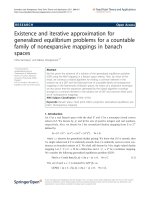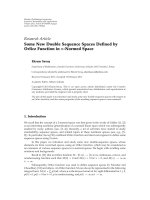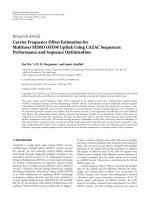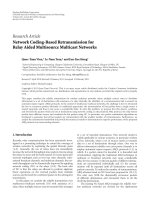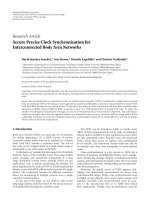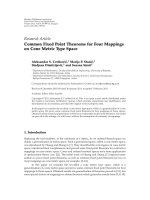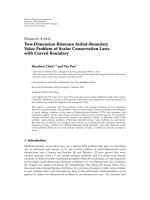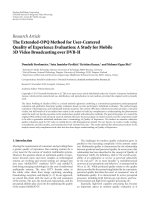báo cáo hóa học:" Research Article Two New Iterative Methods for a Countable Family of Nonexpansive Mappings in Hilbert Spaces" pdf
Bạn đang xem bản rút gọn của tài liệu. Xem và tải ngay bản đầy đủ của tài liệu tại đây (506.59 KB, 12 trang )
Hindawi Publishing Corporation
Fixed Point Theory and Applications
Volume 2010, Article ID 852030, 12 pages
doi:10.1155/2010/852030
Research Article
Two New Iterative Methods for a Countable Family
of Nonexpansive Mappings in Hilbert Spaces
Shuang Wang
1
and Changsong Hu
2
1
School of Mathematical Sciences, Yancheng Teachers University, Yancheng, Jiangsu 224051, China
2
Department of Mathematics, Hubei Normal University, Huangshi 435002, China
Correspondence should be addressed to Shuang Wang,
Received 6 August 2010; Accepted 5 October 2010
Academic Editor: Tomonari Suzuki
Copyright q 2010 S. Wang and C. Hu. This is an open access article distributed under the Creative
Commons Attribution License, which permits unrestricted use, distribution, and reproduction in
any medium, provided the original work is properly cited.
We consider two new iterative methods for a countable family of nonexpansive mappings in
Hilbert spaces. We proved that the proposed algorithms strongly converge to a common fixed
point of a countable family of nonexpansive mappings which solves the corresponding variational
inequality. Our results improve and extend the corresponding ones announced by many others.
1. Introduction
Let H be a real Hilbert space and let C be a nonempty closed convex subset of H. Recall that a
mapping T : C → C is said to be nonexpansive if Tx−Ty≤x−y, for all x, y ∈ C.Weuse
FT to denote the set of fixed points of T. A mapping F : H → H is called k-Lipschitzian if
there exists a positive constant k such that
Fx − Fy
≤ k
x − y
, ∀x, y ∈ H. 1.1
F is said to be η-strongly monotone if there exists a positive constant η such that
Fx − Fy,x − y
≥ η
x − y
2
, ∀x, y ∈ H. 1.2
Let A be a strongly positive bounded linear operator on H, that is, there exists a
constant γ>0 such that
Ax, x
≥ γ
x
2
, ∀x ∈ H. 1.3
2 Fixed Point Theory and Applications
A typical problem is that of minimizing a quadratic function over the set of the fixed points
of a nonexpansive mapping on a real Hilbert space H:
min
x∈F
T
1
2
Ax, x
−
x, b
, 1.4
where b is a given point in H.
Remark 1.1. From the definition of A, we note that a strongly positive bounded linear operator
A is a A-Lipschitzian and γ-strongly monotone operator.
Construction of fixed points of nonlinear mappings is an important and active research
area. In particular, iterative algorithms for finding fixed points of nonexpansive mappings
have received vast i nvestigation cf. 1, 2 since these algorithms find applications in variety
of applied areas of inverse problem, partial differential equations, image recovery, and signal
processing; see 3–8. One classical way to find the fixed point of a nonexpansive mapping T
is to use a contraction to approximate it. More precisely, take t ∈ 0, 1 and define a contraction
T
t
: C → C by T
t
x tu 1 − tTx, where u ∈ C is a fixed point. Banach’s Contraction
Mapping Principle guarantees that T
t
has a unique fixed point x
t
in C,thatis,
x
t
tu
1 − t
Tx
t
,u∈ C. 1.5
The strong convergence of the path x
t
has been studied by Browder 9 and Halpern 10 in
a Hilbert space.
Recently, Yao et al. 11 considered the following algorithms:
x
t
TP
C
1 − t
x
t
, 1.6
and for x
0
∈ C arbitrarily,
y
n
P
C
1 − α
n
x
n
,
x
n1
1 − β
n
x
n
β
n
Ty
n
,n≥ 0.
1.7
They proved that if {α
n
} and {β
n
} satisfying appropriate conditions, then the {x
t
} defined by
1.6 and {x
n
} defined by 1.7 converge strongly to a fixed point of T.
On the other hand, Yamada 12 introduced the following hybrid iterative method for
solving the variational inequality:
x
n1
Tx
n
− μλ
n
F
Tx
n
,n≥ 0, 1.8
where F is a k-Lipschitzian and η-strongly monotone operator with k>0, η>0, 0 <μ<
2η/k
2
. Then he proved that {x
n
} generated by 1.8 converges strongly to the unique solution
of variational inequality F x, x − x≥0, x ∈ FT.
In this paper, motivated and inspired by the above results, we introduce two new
algorithms 3.3 and 3.13 for a countable family of nonexpansive mappings in Hilbert
spaces. We prove that the proposed algorithms strongly converge to x
∗
∈
∞
n1
FT
n
which
solves the variational inequality: Fx
∗
,x
∗
− u≤0, u ∈
∞
n1
FT
n
.
Fixed Point Theory and Applications 3
2. Preliminaries
Let H be a real Hilbert space with inner product ·, · and norm ·. For the sequence {x
n
} in
H, we write x
n
xto indicate that the sequence {x
n
} converges weakly to x. x
n
→ x implies
that {x
n
} converges strongly to x. For every point x ∈ H, there exists a unique nearest point
in C, denoted by P
C
x such that
x − P
C
x
≤
x − y
, ∀y ∈ C. 2.1
The mapping P
C
is called the metric projection of H onto C. It is well know that P
C
is a
nonexpansive mapping. In a real Hilbert space H, we have
x − y
2
x
2
y
2
− 2
x, y
, ∀x, y ∈ H. 2.2
In order to prove our main results, we need the following lemmas.
Lemma 2.1 see 13. Let H be a Hilbert space, C a closed convex subset of H, and T : C → C
a nonexpansive mapping with FT
/
∅,if{x
n
} is a sequence in C weakly converging to x and if
{I − Tx
n
} converges strongly to y,thenI − Tx y.
Lemma 2.2 see 14. Let {x
n
} and {z
n
} be bounded sequences in Banach space E and {γ
n
} a
sequence in 0, 1 which satisfies the following condition:
0 < lim inf
n →∞
γ
n
≤ lim sup
n →∞
γ
n
< 1. 2.3
Suppose that x
n1
γ
n
x
n
1 − γ
n
z
n
, n ≥ 0 and lim sup
n →∞
z
n1
− z
n
−x
n1
− x
n
≤ 0.
Then lim
n →∞
z
n
− x
n
0.
Lemma 2.3 see 15, 16. Let {s
n
} be a sequence of nonnegative real numbers satisfying
s
n1
≤
1 − λ
n
s
n
λ
n
δ
n
γ
n
,n≥ 0, 2.4
where {λ
n
}, {δ
n
}, and {γ
n
} satisfy the following conditions: i {λ
n
}⊂0, 1 and
∞
n0
λ
n
∞, ii
lim sup
n →∞
δ
n
≤ 0 or
∞
n0
λ
n
δ
n
< ∞, iii γ
n
≥ 0 n ≥ 0,
∞
n0
γ
n
< ∞.Thenlim
n →∞
s
n
0.
Lemma 2.4 see 17, Lemma 3.2. Let C be a nonempty closed convex subset of a Banach space E.
Suppose that
∞
n1
sup
{
T
n1
z − T
n
z
: z ∈ C
}
< ∞. 2.5
Then, for each y ∈ C, {T
n
y} converges strongly to some point of C. Moreover, let T be a mapping of C
into itself defined by Ty lim
n →∞
T
n
y, for all y ∈ C.Thenlim
n →∞
sup{Tz− T
n
z : z ∈ C} 0.
4 Fixed Point Theory and Applications
Lemma 2.5. Let F be a k-Lipschitzian and η-strongly monotone operator on a Hilbert space H with
0 <η≤ k and 0 <t<η/k
2
.ThenS I − tF : H → H is a contraction with contraction
coefficient τ
t
1 − t2η − tk
2
.
Proof. From 1.1, 1.2,and2.2, we have
Sx − Sy
2
x − y
− t
Fx − Fy
2
x − y
2
t
2
Fx − Fy
2
− 2t
Fx − Fy,x − y
≤
x − y
2
t
2
k
2
x − y
2
− 2tη
x − y
2
1 − t
2η − tk
2
x − y
2
,
2.6
for all x, y ∈ H.From0<η≤ k and 0 <t<η/k
2
, we have
Sx − Sy
≤ τ
t
x − y
, 2.7
where τ
t
1 − t2η − tk
2
. Hence S is a contraction with contraction coefficient τ
t
.
3. Main Results
Let F be a k-Lipschitzian and η-strongly monotone operator on H with 0 <η≤ k and T : C →
C a nonexpansive mapping. Let t ∈ 0,η/k
2
and τ
t
1 − t2η − tk
2
; consider a mapping
S
t
on C defined by
S
t
x TP
C
I − tF
x
,x∈ C. 3.1
It is easy to see that S
t
is a contraction. Indeed, from Lemma 2.5, we have
S
t
x − S
t
y
≤
TP
C
I − tF
x
− TP
C
I − tF
y
≤
I − tF
x −
I − tF
y
≤ τ
t
x − y
,
3.2
for all x, y ∈ C. Hence it has a unique fixed point, denoted x
t
, which uniquely solves the fixed
point equation
x
t
TP
C
I − tF
x
t
,x
t
∈ C. 3.3
Theorem 3.1. Let C be a nonempty closed convex subset of a real Hilbert space H.LetT : C → C
be a nonexpansive mapping such that FT
/
∅.LetF be a k-Lipschitzian and η-strongly monotone
Fixed Point Theory and Applications 5
operator on H with 0 <η≤ k. For each t ∈ 0,η/k
2
, let the net {x
t
} be generated by 3.3. Then, as
t → 0, the net {x
t
} converges strongly to a fixed point x
∗
of T which solves the variational inequality:
Fx
∗
,x
∗
− u
≤ 0,u∈ F
T
. 3.4
Proof. We first show the uniqueness of a solution of the variational inequality 3.4, which is
indeed a consequence of the strong monotonicity of F.Supposex
∗
∈ FT and x ∈ FT both
are solutions to 3.4; then
Fx
∗
,x
∗
− x
≤ 0,
F x, x − x
∗
≤0.
3.5
Adding up 3.5 gets
Fx
∗
− F x, x
∗
− x
≤ 0. 3.6
The strong monotonicity of F implies that x
∗
x and the uniqueness is proved. Below we
use x
∗
∈ FT to denote the unique solution of 3.4.
Next, we prove that {x
t
} is bounded. Take u ∈ FT;from3.3 and using Lemma 2.5,
we have
x
t
− u
TP
C
I − tF
x
t
− TP
C
u
≤
I − tF
x
t
− u
≤
I − tF
x
t
−
I − tF
u − tFu
≤
I − tF
x
t
−
I − tF
u
t
Fu
≤ τ
t
x
t
− u
t
Fu
,
3.7
that is,
x
t
− u
≤
t
1 − τ
t
Fu
. 3.8
Observe that
lim
t → 0
t
1 − τ
t
1
η
. 3.9
From t → 0, we may assume, without loss of generality, that t ≤ η/k
2
− . Thus, we have that
t/1 − τ
t
is continuous, f or all t ∈ 0,η/k
2
− . Therefore, we obtain
sup
t
1 − τ
t
: t ∈
0,
η
k
2
−
< ∞. 3.10
From 3.8 and 3.10, we have that {x
t
} is bounded and so is {Fx
t
}.
6 Fixed Point Theory and Applications
On the other hand, from 3.3,weobtain
x
t
− Tx
t
TP
C
I − tF
x
t
− TP
C
x
t
≤
I − tF
x
t
− x
t
t
Fx
t
−→ 0
t −→ 0
.
3.11
To prove that x
t
→ x
∗
. For a given u ∈ FT,by2.2 and using Lemma 2.5, we have
x
t
− u
2
TP
C
I − tF
x
t
− TP
C
u
2
≤
I − tF
x
t
−
I − tF
u − tFu
2
≤ τ
t
2
x
t
− u
2
t
2
Fu
2
2t
I − tF
u −
I − tF
x
t
,Fu
≤ τ
t
x
t
− u
2
t
2
Fu
2
2t
u − x
t
,Fu
2t
2
Fx
t
− Fu,Fu
≤ τ
t
x
t
− u
2
t
2
Fu
2
2t
u − x
t
,Fu
2t
2
k
x
t
− u
Fu
.
3.12
Therefore,
x
t
− u
2
≤
t
2
1 − τ
t
Fu
2
2t
1 − τ
t
u − x
t
,Fu
2t
2
k
1 − τ
t
x
t
− u
Fu
. 3.13
From τ
t
1 − t2η − tk
2
, we have lim
t → 0
t
2
/1 − τ
t
0 and lim
t → 0
2t
2
k/1 − τ
t
0.
Observe that, if x
t
u, we have lim
t → 0
2t/1 − τ
t
u − x
t
,Fu 0.
Since {x
t
} is bounded, we see that if {t
n
} is a sequence in 0,η/k
2
− such that t
n
→ 0
and x
t
n
x, then by 3.13,weseex
t
n
→ x. Moreover, by 3.11 and using Lemma 2.1,we
have x ∈ FT. We next prove that x solves the variational inequality 3.4.From3.3 and
u ∈ FT, we have
x
t
− u
2
≤
I − tF
x
t
− u
2
x
t
− u
2
t
2
Fx
t
2
− 2t
Fx
t
,x
t
− u
,
3.14
that is,
Fx
t
,x
t
− u
≤
t
2
Fx
t
2
. 3.15
Now replacing t in 3.15 with t
n
and letting n →∞, we have
F x, x − u
≤ 0. 3.16
That is x ∈ FT is a solution of 3.4; hence x x
∗
by uniqueness. In a summary, we have
shown that each cluster point of {x
t
} as t → 0 equals x
∗
. Therefore, x
t
→ x
∗
as t → 0.
Fixed Point Theory and Applications 7
Setting F A in Theorem 3.1, we can obtain the following result.
Corollary 3.2. Let C be a nonempty closed convex subset of a real Hilbert space H.LetT : C → C
be a nonexpansive mapping such that FT
/
∅.LetA be a strongly positive bounded linear operator
with coefficient 0 < γ ≤A. For each t ∈ 0, γ/A
2
, let the net {x
t
} be generated by x
t
TP
C
I −tAx
t
. Then, as t → 0, the net {x
t
} converges strongly to a fixed point x
∗
of T which solves
the variational inequality:
Ax
∗
,x
∗
− u
≤ 0,u∈ F
T
. 3.17
Setting F I, the identity mapping, in Theorem 3.1, we can obtain the following result.
Corollary 3.3. Let C be a nonempty closed convex subset of a real Hilbert space H.LetT : C → C
be a nonexpansive mapping such that FT
/
∅. For each t ∈ 0, 1, let the net {x
t
} be generated
by 1.6. Then, as t → 0, the net {x
t
} converges strongly to a fixed point x
∗
of T which solves the
variational inequality:
x
∗
,x
∗
− u
≤ 0,u∈ F
T
. 3.18
Remark 3.4. The Corollary 3.3 complements the results of Theorem 3.1 in Yao et al. 11,that
is, x
∗
is the solution of the variational inequality: x
∗
,x
∗
− u≤0,u∈ FT.
Theorem 3.5. Let C be a nonempty closed convex subset of a real Hilbert space H.Let{T
n
} be a
sequence of nonexpansive mappings of C into itself such that
∞
n1
FT
n
/
∅.LetF be a k-Lipschitzian
and η-strongly monotone operator on H with 0 <η≤ k.Let{α
n
} and {β
n
} be two real sequences in
0, 1 and satisfy the conditions:
A1 lim
n →∞
α
n
0 and
∞
n1
α
n
∞;
A2 0 < lim inf
n →∞
β
n
≤ lim sup
n →∞
β
n
< 1.
Suppose that
∞
n1
sup{T
n1
z − T
n
z : z ∈ B} < ∞ for any bounded subset B of C.
Let T be a mapping of C into itself defined by Tz lim
n →∞
T
n
z for all z ∈ C and suppose t hat
FT
∞
n1
FT
n
. For given x
1
∈ C arbitrarily, let the sequence {x
n
} be generated by
y
n
P
C
I − α
n
F
x
n
,
x
n1
1 − β
n
x
n
β
n
T
n
y
n
,n≥ 1.
3.19
Then the sequence {x
n
} strongly converges to a x
∗
∈
∞
n1
FT
n
which solves the variational
inequality:
Fx
∗
,x
∗
− u≤0,u∈
∞
n1
F
T
n
. 3.20
8 Fixed Point Theory and Applications
Proof. We proceed with the following steps.
Step 1. We claim that {x
n
} is bounded. From lim
n →∞
α
n
0, we may assume, without loss of
generality, that 0 <α
n
≤ η/k
2
− for all n.Infact,letu ∈
∞
n1
FT
n
,from3.19 and using
Lemma 2.5, we have
y
n
− u
P
C
I − α
n
F
x
n
− P
C
u
≤
I − α
n
F
x
n
−
I − α
n
F
u − α
n
Fu
≤ τ
α
n
x
n
− u
α
n
Fu
,
3.21
where τ
α
n
1 − α
n
2η − α
n
k
2
. Then from 3.19 and 3.21 ,weobtain
x
n1
− u
1 − β
n
x
n
− u
β
n
T
n
y
n
− u
≤
1 − β
n
x
n
− u
β
n
y
n
− u
≤
1 − β
n
x
n
− u
β
n
τ
α
n
x
n
− u
α
n
Fu
≤
1 − β
n
1 − τ
α
n
x
n
− u
β
n
α
n
Fu
≤ max
x
n
− u
,
α
n
Fu
1 − τ
α
n
.
3.22
By induction, we have
x
n
− u
≤ max
{
x
1
− u
,M
1
Fu
}
, 3.23
where M
1
sup{α
n
/1 − τ
α
n
:0<α
n
≤ η/k
2
− } < ∞. Therefore, {x
n
} is bounded. We also
obtain that {y
n
}, {T
n
y
n
},and{Fx
n
} are bounded. Without loss of generality, we may assume
that {x
n
}, {y
n
}, {T
n
y
n
},and{Fx
n
}⊂B, where B is a bounded set of C.
Step 2. We claim that lim
n →∞
x
n1
−x
n
0. To this end, define a sequence {z
n
} by z
n
T
n
y
n
.
It follows that
z
n1
− z
n
T
n1
y
n1
− T
n
y
n
≤
T
n1
y
n1
− T
n1
y
n
T
n1
y
n
− T
n
y
n
≤
y
n1
− y
n
T
n1
y
n
− T
n
y
n
≤
I − α
n1
F
x
n1
−
I − α
n
F
x
n
T
n1
y
n
− T
n
y
n
≤
x
n1
− x
n
α
n1
Fx
n1
α
n
Fx
n
sup
{
T
n1
z − T
n
z
: z ∈ B
}
.
3.24
Thus, we have
z
n1
− z
n
−
x
n1
− x
n
≤ α
n1
Fx
n1
α
n
Fx
n
sup
{
T
n1
z − T
n
z
: z ∈ B
}
. 3.25
Fixed Point Theory and Applications 9
From lim
n →∞
α
n
0and3.25, we have
lim sup
n →∞
z
n1
− z
n
−
x
n1
− x
n
≤ 0. 3.26
By 3.26, A2,andusingLemma 2.2, we have lim
n →∞
z
n
− x
n
0. Therefore,
lim
n →∞
x
n1
− x
n
lim
n →∞
β
n
z
n
− x
n
0. 3.27
Step 3. We claim that lim
n →∞
x
n
− T
n
x
n
0. Observe that
x
n
− T
n
x
n
≤
x
n
− x
n1
x
n1
− T
n
x
n
≤
x
n
− x
n1
1 − β
n
x
n
− T
n
x
n
β
n
T
n
y
n
− T
n
x
n
≤
x
n
− x
n1
1 − β
n
x
n
− T
n
x
n
β
n
y
n
− x
n
≤
x
n
− x
n1
1 − β
n
x
n
− T
n
x
n
α
n
Fx
n
,
3.28
that is,
x
n
− T
n
x
n
≤
1
β
n
x
n1
− x
n
α
n
Fx
n
−→ 0
n −→ ∞
. 3.29
Step 4. We claim that lim
n →∞
x
n
− Tx
n
0. Observe that
x
n
− Tx
n
≤
x
n
− T
n
x
n
T
n
x
n
− Tx
n
≤
x
n
− T
n
x
n
sup
{
T
n
z − Tz
: z ∈ B
}
.
3.30
Hence, from Step 3 and using Lemma 2.4, we have
lim
n →∞
x
n
− Tx
n
0. 3.31
Step 5. We claim that lim sup
n →∞
Fx
∗
,x
∗
−x
n
≤0, where x
∗
lim
t → 0
x
t
and x
t
is defined by
3.3. Since x
n
is bounded, there exists a subsequence {x
n
k
} of {x
n
} which converges weakly
to ω.FromStep 4,weobtainTx
n
k
ω.FromLemma 2.1, we have ω ∈ FT. Hence, by
Theorem 3.1, we have
lim sup
n →∞
Fx
∗
,x
∗
− x
n
lim
k →∞
Fx
∗
,x
∗
− x
n
k
Fx
∗
,x
∗
− ω
≤ 0. 3.32
10 Fixed Point Theory and Applications
Step 6. We claim that {x
n
} converges strongly to x
∗
∈
∞
n1
FT
n
.From3.19, we have
x
n1
− x
∗
2
≤
1 − β
n
x
n
− x
∗
2
β
n
T
n
y
n
− x
∗
2
≤
1 − β
n
x
n
− x
∗
2
β
n
y
n
− x
∗
2
≤
1 − β
n
x
n
− x
∗
2
β
n
I − α
n
F
x
n
−
I − α
n
F
x
∗
− α
n
Fx
∗
2
≤
1 − β
n
x
n
− x
∗
2
β
n
τ
2
α
n
x
n
− x
∗
2
α
2
n
Fx
∗
2α
n
I − α
n
F
x
∗
−
I − α
n
F
x
n
,Fx
∗
≤
1 − β
n
x
n
− x
∗
2
β
n
τ
α
n
x
n
− x
∗
2
β
n
α
2
n
Fx
∗
2
2α
n
β
n
x
∗
− x
n
,Fx
∗
2β
n
α
2
n
Fx
n
− Fx
∗
,Fx
∗
≤
1 − β
n
1 − τ
α
n
x
n
− x
∗
2
β
n
α
2
n
Fx
∗
2
2α
n
β
n
x
∗
− x
n
,Fx
∗
2β
n
α
2
n
k
x
n
− x
∗
Fx
∗
≤
1 − β
n
1 − τ
α
n
x
n
− x
∗
2
β
n
α
2
n
M
2
2α
n
β
n
x
∗
− x
n
,Fx
∗
2β
n
α
2
n
M
2
≤
1 − β
n
1 − τ
α
n
x
n
− x
∗
2
β
n
1 − τ
α
n
3α
2
n
M
2
1 − τ
α
n
2M
1
x
∗
− x
n
,Fx
∗
1 − λ
n
x
n
− x
∗
2
λ
n
δ
n
,
3.33
where M
2
sup{Fx
∗
2
,kx
n
− x
∗
Fx
∗
}, λ
n
β
n
1 − τ
α
n
,andδ
n
3α
2
n
M
2
/1 − τ
α
n
2M
1
x
∗
− x
n
,Fx
∗
. It is easy to see that λ
n
→ 0,
∞
n1
λ
n
∞, and lim sup
n →∞
δ
n
≤ 0.
Hence, by Lemma 2.3, the sequence {x
n
} converges strongly to x
∗
∈
∞
n1
FT
n
.Fromx
∗
lim
t → 0
x
t
and Theorem 3.1, we have that x
∗
is the unique solution of the variational inequality:
Fx
∗
,x
∗
− u≤0,u∈
∞
n1
FT
n
.
Remark 3.6. From Remark 3.1 of Peng and Yao 18,weobtainthat{W
n
} is a sequence of
nonexpansive mappings satisfying condition
∞
n1
sup{W
n1
z − W
n
z : z ∈ B} < ∞ for
any bounded subset B of H. Moreover, let W be the W-mapping; we know that Wy
lim
n →∞
W
n
y for all y ∈ C and that FW
∞
n1
FW
n
. If we replace {T
n
} by {W
n
}
in the recursion formula 3.19, we can obtain the corresponding results of the so-called
W-mapping.
Setting F A and T
n
T in Theorem 3.5, we can obtain the following result.
Corollary 3.7. Let C be a nonempty closed convex subset of a real Hilbert space H.LetT : C → C
be a nonexpansive mapping such that FT
/
∅.LetA be a strongly positive bounded linear operator
with coefficient 0 < γ ≤A.Let{α
n
} and {β
n
} be two real sequences in 0, 1 and satisfy the
conditions (A1) and (A2). For given x
1
∈ C arbitrarily, let the sequence {x
n
} be generated by
y
n
P
C
I − α
n
A
x
n
,
x
n1
1 − β
n
x
n
β
n
Ty
n
,n≥ 1.
3.34
Fixed Point Theory and Applications 11
Then the sequence {x
n
} strongly converges to a fixed point x
∗
of T which solves the variational
inequality:
Ax
∗
,x
∗
− u
≤ 0,u∈ F
T
. 3.35
Setting F I and T
n
T in Theorem 3.5, we can obtain the following result.
Corollary 3.8. Let C be a nonempty closed convex subset of a real Hilbert space H.LetT : C → C
be a nonexpansive mapping such that FT
/
∅.Let{α
n
} and {β
n
} be two real sequences in 0, 1
and satisfy the conditions (A1) and (A2). For given x
1
∈ C arbitrarily, let the sequence {x
n
} be
generated by 1.7. Then t he sequence {x
n
} strongly converges to a fixed point x
∗
of T which solves
the variational inequality:
x
∗
,x
∗
− u
≤ 0,u∈ F
T
. 3.36
Remark 3.9. The Corollary 3.8 complements the results of Theorem 3.2 in Yao et al. 11,that
is, x
∗
is the solution of the variational inequality: x
∗
,x
∗
− u≤0,u∈ FT.
Acknowledgment
This paper is supported by the National Science Foundation of China under Grant
10771175.
References
1 S. Reich, “Almost convergence and nonlinear ergodic theorems,” Journal of Approximation Theory, vol.
24, no. 4, pp. 269–272, 1978.
2 K. Goebel and S. Reich, Uniform Convexity, Hyperbolic Geometry, and Nonexpansive Mappings, vol. 83 of
Monographs and Textbooks in Pure and Applied Mathematics, Marcel Dekker Inc., New York, NY, USA,
1984.
3 C. Byrne, “A unified treatment of some iterative algorithms in signal processing and image
reconstruction,” Inverse Problems, vol. 20, no. 1, pp. 103–120, 2004.
4 D. Youla, “Mathematical theory of image restoration by the method of convex projection,” in Image
Recovery Theory and Applications, H. Stark, Ed., pp. 29–77, Academic Press, Orlando, Fla, USA, 1987.
5 C. I. Podilchuk and R. J. Mammone, “Image recovery by convex projections using a least-squares
constraint,” Journal of the Optical Society of America, vol. 7, no. 3, pp. 517–512, 1990.
6 P. L. Combettes, “On the n umerical robustness of the parallel projection method in signal synthesis,”
IEEE Signal Processing Letters, vol. 8, no. 2, pp. 45–47, 2001.
7 H. W. Engl and A. Leit
˜
ao, “A Mann iterative regularization method for elliptic Cauchy problems,”
Numerical Functional Analysis and Optimization, vol. 22, no. 7-8, pp. 861–884, 2001.
8 P. L. Combettes, “The convex feasibility problem in image recovery,” in Advances in Imaging and
Electron Physics, P. Hawkes, Ed., vol. 95, pp. 155–270, Academic Press, New York, NY, USA, 1996.
9 F. E. Browder, “Fixed-point theorems for noncompact mappings in Hilbert space,” Proceedings of the
National Academy of Sciences of the United States of America, vol. 53, pp. 1272–1276, 1965.
10 B. Halpern, “Fixed points of nonexpanding maps,” Bulletin of the American Mathematical Society, vol.
73, pp. 957–961, 1967.
11 Y. Yao, Y. C. Liou, and G. Marino, “Strong convergence of two iterative algorithms for nonexpansive
mappings in Hilbert spaces,” Fixed Point Theory and Applications, vol. 2009, Article ID 279058, 7 pages,
2009.
12 Fixed Point Theory and Applications
12 I. Yamada, “The hybrid steepest descent method for the variational inequality problem over the
intersection of fixed point sets of nonexpansive mappings,” in Inherently Parallel Algorithms in
Feasibility and Optimization and Their Applications (Haifa, 2000), D. Butnariu, Y. Censor, and S. Reich,
Eds., vol. 8 of Stud. Comput. Math., pp. 473–504, North-Holland, Amsterdam, The Netherlands, 2001.
13 K. Goebel and W. A. Kirk, Topics in Metric Fixed Point Theory, vol. 28 of Cambridge Studies in Advanced
Mathematics, Cambridge University Press, Cambridge, UK, 1990.
14 T. Suzuki, “Strong convergence of Krasnoselskii and Mann’s type sequences for one-parameter non-
expansive semigroups without Bochner integrals,” Journal of Mathematical Analysis and Applications,
vol. 305, no. 1, pp. 227–239, 2005.
15 L. S. Liu, “Ishikawa and Mann iterative process with errors for nonlinear strongly accretive mappings
in Banach spaces,” Journal of Mathematical Analysis and Applications, vol. 194, no. 1, pp. 114–125, 1995.
16 H K. Xu, “Iterative algorithms for nonlinear operators,” Journal of the London Mathematical Society,
vol. 66, no. 1, pp. 240–256, 2002.
17 K. Aoyama, Y. Kimura, W. Takahashi, and M. Toyoda, “Approximation of common fixed points of a
countable family of nonexpansive mappings in a Banach space,” Nonlinear Analysis: Theory, Methods
& Applications, vol. 67, no. 8, pp. 2350–2360, 2007.
18 J W. Peng and J C. Yao, “A viscosity approximation scheme for system of equilibrium problems,
nonexpansive mappings and monotone mappings,” Nonlinear Analysis: Theory, Methods & Applica-
tions, vol. 71, no. 12, pp. 6001–6010, 2009.
